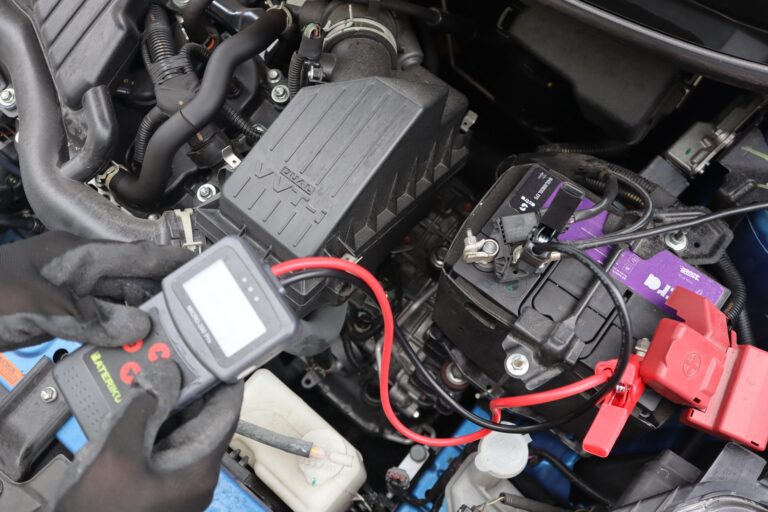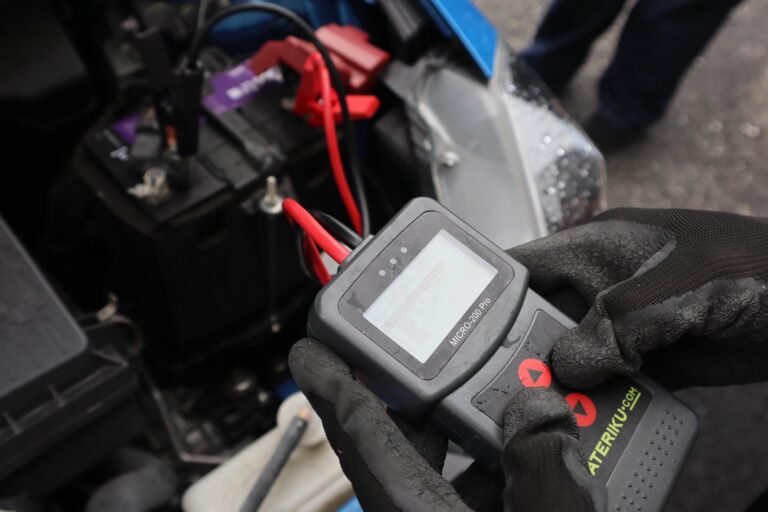How To Check Car Battery Health:
A Step-by-step Guide
A car battery is one of the most important parts of the car, often called the heart of your car’s electrical system as it provides the power needed to start the engine and operate electrical components in the car such as the wiper, radio, headlights and more.
It’s important to regularly check your car battery’s health to ensure your car runs smoothly without any issues and also to prevent unexpected breakdowns. To find out more on how to check your car battery health, carry on reading this guide!

Importance of Checking Car Battery Health Regularly
Checking your car battery health regularly can help
Prevent any unexpected breakdowns leaving you stranded on the road.
Avoid costly repairs due to poor maintenance.
Identify any potential issues that can be easily fixed, which can help you save money and time in the long run.
Extend the life of your car battery.
Ensure your car’s electrical system operates correctly.
Gather Necessary Tools and Equipment
Before you start your regular battery health checks, first you will need to gather the necessary tools and equipment. If you’re wondering how to check car battery health, here are some of the tools and equipment needed:
A multimeter to test the voltage of the battery.
A battery load tester for load testing.
Safety gloves and goggles.
A wrench to remove terminal connections if needed.
Baking soda and water solution to clean terminals.
Safety Precautions Before Starting
It’s crucial to follow safety precautions before starting car battery health checks. Here are some safety precautions you need to know before starting:
Use Protective Gear
Ensure you use safety gloves and goggles before you start to protect against acid spills.
Work in a Ventilated Area
Always perform car battery checks in a well-ventilated area to avoid inhaling any harmful fumes.
Avoid Open Flames
Avoid performing car battery checks in areas where there are flames, sparks or any ignition sources.
Disconnect the Car Battery
For performing in-depth tests, ensure you disconnect the negative terminal first to avoid short circuits.

Step-by-Step Guide on How to Check Car Battery Health
If you’re wondering how to check car battery health, here is a step-by-step guide to help you through the process of performing a successful battery health check.
Visual Inspection of the Car Battery
Firstly, check for corrosion. Look for white, ashy deposits around the car battery terminals. You may want to clean them if necessary. Then, inspect the battery case. You can check for cracks, and any swelling or leaks around and in the battery case. Ensure there is no visible damage or any loose parts.
Checking Battery Terminals and Connections
Next, check the car battery terminals and connections. Ensure all connections are tight and secure. Clean the terminals if you find them corroded. You can clean the terminals using baking soda and water solution and then rinse with clean water. Check also for loose wires. Ensure all wires are securely connected to the terminals.
Testing the Battery Voltage with a Multimeter
To test the car battery voltage, you will need a multimeter. Set your multimeter to the DC voltage setting. Then, connect the multimeter by attaching the red probe to the positive terminal and the black probe to the negative terminal. The voltage for a fully charged car battery should read between 12.6 to 12.8 volts. A car battery below 12.4 volts indicated that the battery might need charging.
Conducting a Load Test
To conduct a load test, first, prepare the battery. Ensure the car battery is fully charged before conducting a load test. Then connect the load tested by attaching the load tested to the battery terminals following the device instructions. Next, apply the load for the recommended time which is usually 10 to 15 seconds. If the voltage drops and doesn’t recover fast, this indicates that the car battery might be weak.
Analysing Test Results
During a load test, the car battery voltage should stay above 9.6 volts which means the battery is healthy. A weak car battery shows a voltage reading of below 9.6 volts, indicating a potential battery issue. However, if the voltage reading drops below 7 volts, most likely the car battery is failing and needs a replacement.
When to Replace Your Car Battery?
If you’re not sure when to replace your car battery, don’t fret, we’ve got a list for you right here. Here’s when you should replace your car battery:
Age of the Car Battery
Car batteries typically last between 3 to 5 years. If your battery is within this range, it may be time to consider a battery replacement.
Visible Signs of Damage
After doing your regular car battery health checks, if you find that there are visible signs of damage like leaks or swelling of the battery, it may need a replacement.
Difficulty Starting the Engine
If you notice that when starting your engine it cranks more slowly than usual, it could be a sign that the car battery is weak.
Fails Load Test
If you’ve done the load test and it fails whereby the car battery cannot maintain a voltage above 9.6 volts, it’s a sign that your car battery needs a replacement.
The Voltage Reading is Low
During the voltage checks, if you find that the reading is consistently low, it’s most likely time for a new car battery replacement.
Remember to Regularly Check Your Car Battery Health
Regularly having battery health checks is important for so many reasons. Not only does it prevent unexpected breakdowns, but also helps you save money in the long run. Regularly monitoring your car battery ensures your car runs smoothly and efficiently. However, to perform successful battery health checks, it’s important to follow the step-by-step guide.
If you need any assistance regarding your car battery, don’t hesitate to contact Bateriku.com for a free car battery delivery. We also offer new car battery replacements with just a few taps on your mobile phone. No matter where you are located, we are here to help you!
